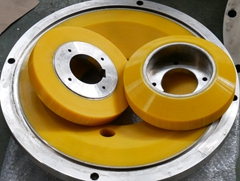Bonding of casting polyurethane and metal
 In most
polyurethane casting products such as rubber rollers, solid wheels, couplings,
ceramic molds, liners, sieve plates, etc., the adhesion of casting polyurethane
and metal is involved. Therefore, the problem of adhesion between casting
polyurethane and metal must be solved in production. When bonding between casting
polyurethane and metal, if the metal surface is treated properly and the
selected adhesive is suitable, excellent bonding strength can be obtained. At
present, the types of polyurethane elastomers and metal transition adhesives
(primers) available are: NA-1 polyurethane adhesive; Chemlock218, 213, 219,
Conap1146, 1146C; Thixon422, 423, 403, 404 (Rohm and Haas Company in the United
States) and Cilbond48C, 49.
In most
polyurethane casting products such as rubber rollers, solid wheels, couplings,
ceramic molds, liners, sieve plates, etc., the adhesion of casting polyurethane
and metal is involved. Therefore, the problem of adhesion between casting
polyurethane and metal must be solved in production. When bonding between casting
polyurethane and metal, if the metal surface is treated properly and the
selected adhesive is suitable, excellent bonding strength can be obtained. At
present, the types of polyurethane elastomers and metal transition adhesives
(primers) available are: NA-1 polyurethane adhesive; Chemlock218, 213, 219,
Conap1146, 1146C; Thixon422, 423, 403, 404 (Rohm and Haas Company in the United
States) and Cilbond48C, 49.
In order to
obtain the ideal bonding strength, in addition to choosing a good adhesive, the
entire bonding process must be carefully operated. First, the metal is
roughened with sandpaper or sandblasted (shot) to make the surface rough. The
purpose is to expand the bonding area and activate the surface. Then deesterify
in trichloroethylene or toluene deesterification tank (the effect of
deesterification is better in trichloroethylene evaporation and
deesterification tank) and dry. Then follow the standard rubber-to-metal bonding
procedure or the method recommended by the adhesive manufacturer. Use a brush
to coat or spray a certain thickness of adhesive, leave it to dry, and let the
solvent fully evaporate. After the metal is preheated, pour the polyurethane
compound










